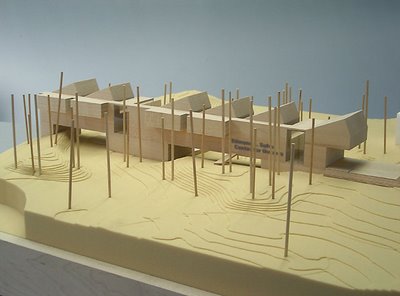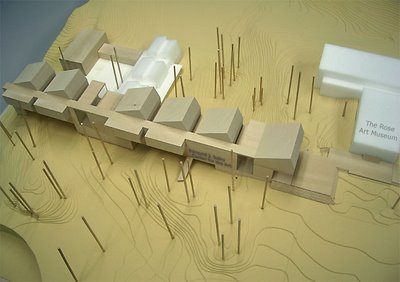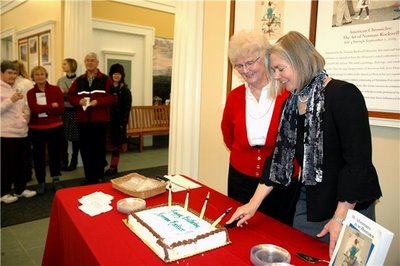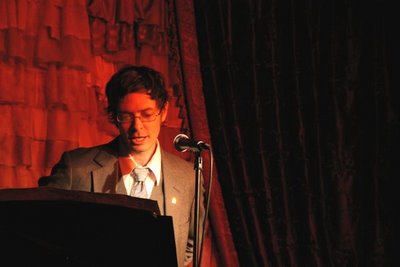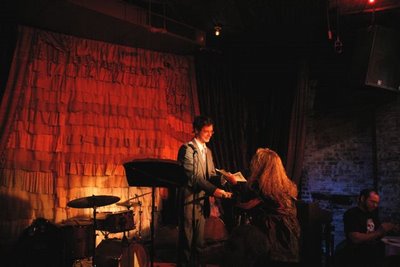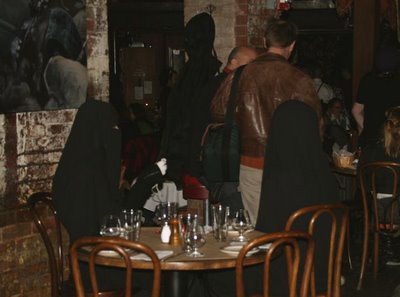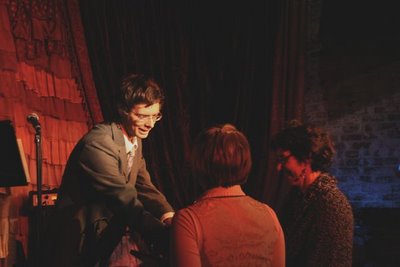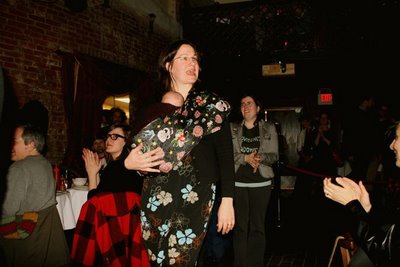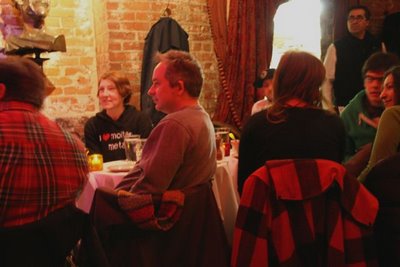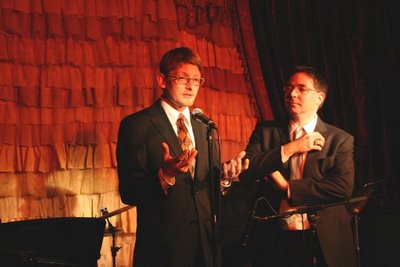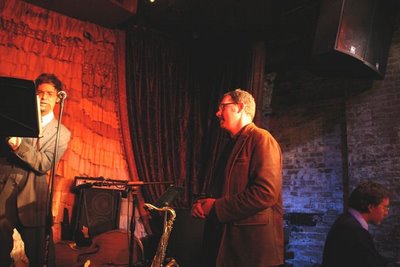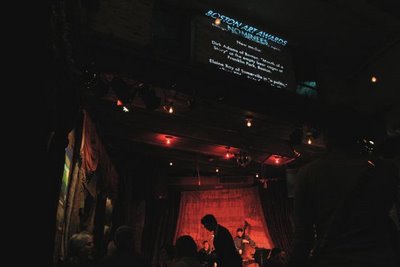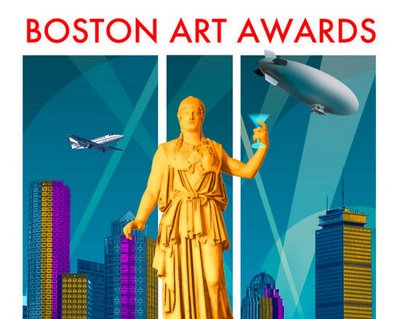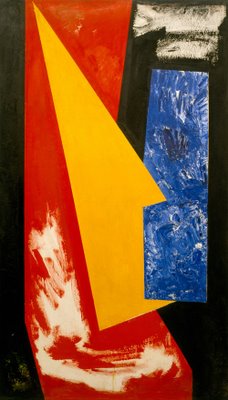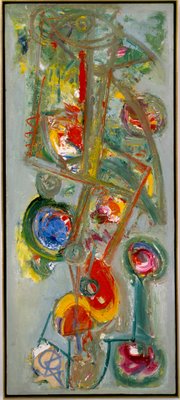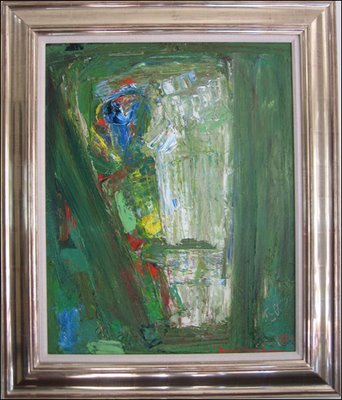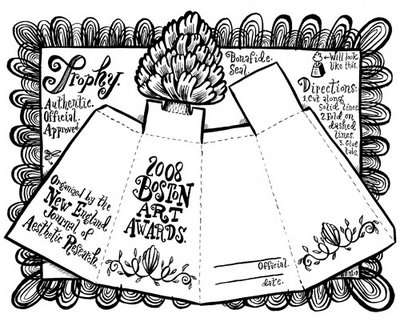
The winners of the 2008 Boston Art Awards, which were organized by The New England Journal of Aesthetic Research, were announced at the Beehive in Boston tonight. More than 60 people made some 180 nominations, and some 600 people voted. Participating critics included: Edgar Allen Beem, Greg Cook, Evan Garza, Shawn Hill, Christian Holland, Francine Koslow Miller, Shirley B. Moskow, Matt Nash, and Doug Norris. Winners were awarded the certificate-trophy pictured above.
Installation:Critics’ pick:
• Andrew Witkin of Boston in ICA’s Foster Prize exhibit, November 2008 to March 2009.
People’s choice:
• Jacob Berendes, HBML Junk Shoppe, Worcester, forever.
Photography:Critics’ pick:
• Judy Haberl of Newtonville, MA, Gallery Kayafas, March to April.
People’s choice:
• Jess T. Dugan of Cambridge, Gallery Kayafas, September to October.
Painting:Critics’ pick:
• Raul Gonzalez of Somerville, “Chingasos,” New England Gallery of Latin American Art in East Boston, May.
People’s choice:
• Neal Walsh of Providence, 5 Traverse, April.
Drawing and printmaking:Critics’ pick:
• Mary O'Malley of Somerville in “Overflow,” Laconia, October to November.
People’s choice:
• Brian Chippendale of Providence, “Human Mold,” Stairwell, May to June.
New media:Critics’ pick:
• Suara Welitoff of Cambridge, “Anonymous,” Allston Skirt, February to March.
People’s choice (tie):
• Dirk Adams of Roslindale, "Mouth of a Story" at the empty bear cages at Franklin Park, Boston.
• Catherine D'Ignazio of Waltham in the ICA’s Foster Prize exhibit, November 2008 to March 2009.
Sculpture:Critics’ pick:
• Dave Cole of Providence, “All American,” Rotenberg Gallery, September to October.
People’s choice:
• Xander Marro of Providence in “NetWorks 2008” at AS220, Newport Art Museum, 5 Traverse, October 2008 to January 2009.
Public exposure:Critics’ pick:
• Platform2 of Boston [Catherine D’Ignazio (aka Kanarinka) of Waltham, Savic Rasovic (aka Sasha and Pirun) of Cambridge, Andi Sutton of JP and Jane Marsching of Roslindale], “Parade for the Future,” Boston Common, September.
People’s choice:
• “Providence Art Windows,” exhibits in Providence storefronts, throughout the year.
Book:Critics’ pick:
• Caleb Neelon of Cambridge, “Book of Awesome,” Ginko Press.
People’s choice:
• Jo Dery of Providence, “Quietly Sure - Like the Keeper of a Great Secret,” Little Otsu.
Career survey of an artist with local ties:Critics’ pick:
• Corita Kent, late of Boston, ‘We Can Create Life Without War,” Breslin Fine Art, organized by Joanne Breslin, April to May.
People’s choice:
• “Harry Callahan: Eleanor” at RISD Museum, late Providence photographer, organized by Atlanta’s High Museum of Art, November 2008 to February 2009.
Current events (art most reflecting our times):Critics’ pick:
• Catherine D'Ignazio of Waltham in the ICA’s Foster Prize exhibit, November 2008 to March 2009.
People’s choice:
• Dave Cole of Providence, “All American,” Rotenberg Gallery, September to October.
Awesomest spectacle:Critics’ pick:
• Ben Sloat of Jamaica Plain, street performance of “Thriller” as part of his exhibit “I’m Not Like the Other Guys” at OHT Gallery, September.
People’s choice:
• Iron Guild of Boston and Maine for its 6th Annual Halloween Pour at the Steel Yard, Oct. 31.
Best reflection of our local community:Critics’ pick:
No critics’ pick.
People’s choice:
• Jess T. Dugan of Cambridge at Gallery Kayafas, September to October.
The decline and fall of civilization:Critics’ pick:
• Tom Deininger of Newport, RI, in "Trash" at 5 Traverse, September to October.
People’s choice:
• Brian Chippendale of Providence, “Human Mold,” Stairwell, May to June.
Solo artist from Away – non-gallery:Critics’ pick AND People’s choice:
• Tara Donovan of Brooklyn, ICA, curated by the ICA’s Nicholas Baume and Jen Mergel, October 2008 to January 2009.
Locally-curated historical show:Critics’ pick:
• “To the Ends of the Earth,” Peabody Essex Museum, curated by PEM’s Samuel Scott, November 2008 to March 2009.
People’s choice:
• “Social Photography Across a Century: The Works of American Master Lewis Hine and Contemporary Artist Scott Lapham [of Providence],” Slater Mill Gallery, curated by Slater Mill’s Andrian Paquette, Pawtucket, April to June.
Prettiest:Critics’ pick:
• “In Pursuit of Beauty,” Montserrat College of Art, curated by Leonie Bradbury, November 2008 to January 2009.
People’s choice:
• “Drawn to Detail,” DeCordova Museum, organized by DeCordova’s Rachel Rosenfield Lafo, Kate Dempsey and Nina Bozicnik, August 2008 to January 2009.
Big idea show:Critics’ pick:
• “This is Boston, Not LA,” LaMontagne Gallery, curated by Emily Isenberg and Russell LaMontagne, November to December.
People’s choice:
• "Hecho a Mano: New Visions of Latin Contemporary Art,” Center for Latino Art, curated by Evan Garza, September to October.
Local curator of locally-made art:Critics’ pick:
• Maggie Holtzberg, “Keepers of Tradition,” National Heritage Museum, May 2008 to June 2009.
People’s choice:
• Neal Walsh and Mike Taylor, "New Obstructions,” AS220’s Mercantile Block, September to October.
Standout performance by a local artist in a group show:Critics’ pick:
• Andrew Witkin of Boston in ICA’s Foster Prize exhibit, November 2008 to March 2009.
People’s choice:
• Leif Goldberg of Providence in “Sound Beings,” Stairwell Gallery, March to April.
Solo show by local artist (or collaborative):Critics’ pick:
• John Bisbee of Brunswick, Maine, “Bright Common Spikes,” Portland Museum of Art, curated by Susan Danly, January to March.
People’s choice:
• Mike Taylor of Providence (now Florida) “Glitter Disco Synthesizer Nite School,” Stairwell, December.







